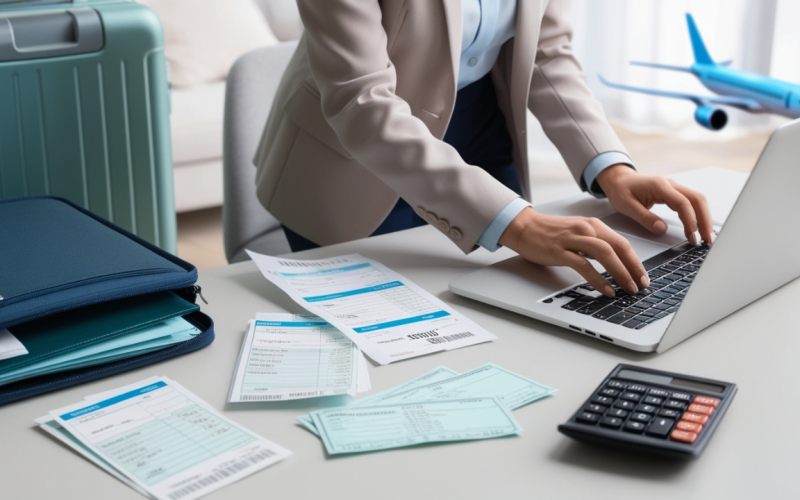Pactrans Request for Travel Reimbursement,Traveling for work often involves expenses that employees can reclaim. Pactrans has established a structured process to help employees request travel reimbursements accurately and efficiently. This guide covers each step, from preparation and submission to troubleshooting and best practices, ensuring a smooth reimbursement experience.
Key Takeaways
- Follow Pactrans’ travel reimbursement steps to avoid delays.
- Submit all necessary documentation to support your expenses.
- Organize receipts and records during the trip for easy access.
- Complete forms accurately to prevent processing issues.
- Use Pactrans’ online system for efficient submission and follow-up.
Introduction to Travel Reimbursement Policies
Why Companies Offer Travel Reimbursement
Travel reimbursement helps employees cover out-of-pocket expenses incurred on business trips. Pactrans, like many companies, offers this benefit to ensure employees are not financially burdened by necessary travel. The company covers expenses within specific limits, focusing on costs essential to the business trip, including accommodations, meals, and transportation.
Pactrans’ Commitment to Supporting Employee Travel Costs
Pactrans aims to streamline the reimbursement process, providing clear guidelines so employees can claim their travel expenses efficiently. Adhering to the company’s process allows both the employee and employer to maintain accurate financial records and ensure compliance with company policies.
Understanding the Pactrans Travel Reimbursement Process
What is Pactrans Travel Reimbursement?
Pactrans provides a process for employees to claim work-related travel expenses, covering costs like lodging, meals, and transportation. Submitting expenses accurately ensures timely reimbursements, benefiting both employees and the organization by maintaining compliance with internal policies.
Why Accurate Travel Reimbursement Matters
Accurate submissions are essential, as incomplete information or errors can delay processing or lead to denied claims. Ensuring all details are correct from the start can prevent potential issues and save time.
Preparing for Your Travel and Expense Tracking
Pre-Approval for Travel
Before taking any business trip, it’s crucial to obtain pre-approval from your supervisor or department head. Pre-approval provides assurance that anticipated expenses align with company policy and that Pactrans will cover them upon submission.
Tracking Expenses During Your Trip
Maintaining an organized record of expenses during your trip can streamline the reimbursement process. It’s helpful to use a travel log, digital expense tracker, or an app like Expensify or QuickBooks to record each cost in real time. Taking photos of receipts as soon as you receive them ensures you don’t lose essential documents, and storing them in a dedicated folder on your phone or device keeps them easy to access.
Recommended Documentation for Reimbursements
For smoother reimbursement, gather specific documentation for each type of expense. Required documents include itemized receipts for lodging, transportation, and meals, along with any necessary approval forms.
| Expense Type | Required Documentation | Tips for Record Keeping |
|---|---|---|
| Lodging | Itemized hotel receipt | Include any discounts or additional fees |
| Transportation | Receipts for taxis, rentals | Note dates, times, and destinations |
| Meals | Receipts with itemized details | Document each meal cost individually |
Maintaining an organized record of receipts and documents can help ensure a complete and accurate reimbursement request.
Completing the Pactrans Request for Travel Reimbursement
Step-by-Step Guide to the Reimbursement Form
The Pactrans reimbursement form must be completed carefully to avoid delays in processing. Start by entering your personal information, including your name, employee ID, and contact details. Next, indicate the purpose of your trip, such as a client meeting or conference, and the exact dates of travel. List each expense with a brief description and associated cost. Clear and specific descriptions help ensure accuracy and minimize follow-up questions from the finance team.
Entering Travel Details and Expenses
When detailing each expense category, separate entries by type, such as lodging, meals, and transportation. Include the name of the establishment, dates, and the total amount paid for each expense. For meal expenses, specify the cost per meal, broken down by date.
Supporting Documents: What to Include
Attach all relevant documents with the form to prevent delays. Pactrans typically requires:
- Receipts for each expense.
- Credit card statements if required by company policy.
- The original approval form indicating prior authorization for the trip.
| Document Type | Why It’s Required | Common Errors to Avoid |
|---|---|---|
| Receipts | Proof of transaction | Ensure clarity in the details on each receipt |
| Credit Card Statement | Verification of payment | Make sure amounts on receipts match statements |
| Approval Form | Confirms pre-authorization | Verify all dates and details match |
Being thorough in providing these documents will support your reimbursement request and expedite processing.
Submitting Your Reimbursement Request
Submitting via the Pactrans System
Once your form is complete, submit it using the Pactrans online portal, which enables you to upload documents and track the status of your reimbursement. To begin, log into the Pactrans portal, locate the “Reimbursements” section, and upload your completed form along with any supporting documents. Review all entries for accuracy before submission to ensure that each detail aligns with Pactrans requirements.
Timeline for Processing and Approval
Following submission, the review and approval process typically takes 5-10 business days. Here is a general timeline to guide expectations:
| Stage | Estimated Time | Notes |
|---|---|---|
| Initial Submission Review | 1-3 business days | Confirmation email sent to your inbox |
| Full Review by Finance Team | 5-7 business days | Additional documentation may be requested |
| Approval Notification | 1 day after final review | Notification confirming approval or request for adjustments |
If the reimbursement request remains unapproved after the expected time, reach out to the finance department for updates.
Following Up on Your Submission
If there are delays or the reimbursement isn’t approved within the expected timeframe, following up with the finance team through the Pactrans portal or by email can provide clarity. Having your request details, including submission date and reference number, on hand can expedite responses.
Troubleshooting Common Issues with Reimbursements
Missing Documentation
If you find that a required document, such as a receipt, is missing, Pactrans has guidelines for acceptable replacements. In some cases, a credit card statement can serve as a backup for certain expenses, while a written explanation may suffice for small expenses. Contact the finance team to confirm acceptable alternatives if you are missing specific documentation.
Expense Discrepancies
Discrepancies between estimated and actual expenses can occur. When this happens, document the reasons behind any variations, such as unforeseen transportation changes, and submit an additional approval form if required. Clearly detailing these adjustments on the form can prevent follow-up questions and additional delays.
Policy Changes or Updates
Travel reimbursement policies may change over time. Checking for updates on Pactrans’ website or asking HR for guidance can ensure that you stay informed about current policies. Subscribing to company email notifications, if available, will keep you updated on any new procedures.
Maximizing Efficiency in Future Travel Reimbursement Requests
Tips for Simplifying Future Expense Tracking
Streamlining your approach to tracking expenses can make future reimbursements easier. Using an expense app such as Concur or QuickBooks simplifies organization and provides a digital record that can be submitted as needed. Setting reminders in your calendar to log expenses daily can further support efficient tracking.
Reviewing Past Submissions for Reference
Referring to previous reimbursement requests can prevent errors and improve accuracy. Keeping digital copies of past forms and using them as a guide for future submissions can help you remember requirements and avoid repetitive mistakes.
| Tip for Efficiency | How It Helps | Example |
|---|---|---|
| Use a tracking app | Automates and organizes expenses | Expensify or QuickBooks |
| Save digital copies | Provides quick reference | Store in a dedicated “Reimbursements” folder |
| Review past forms | Helps prevent mistakes | Reference prior submissions for similar trips |
Types of Expenses Covered by Pactrans Reimbursement
Eligible vs. Ineligible Expenses
Understanding which expenses are eligible for reimbursement is crucial. Generally, Pactrans covers necessary travel-related expenses, including flights, rental cars, taxis, meals, and lodging. However, certain expenses, like entertainment or luxury accommodations beyond a standard rate, are typically ineligible unless explicitly approved.
Expense Categories and Allowable Limits
Each expense type has specific allowable limits. For instance, daily meal expenses are often capped at a per diem rate, and lodging may need to stay within a specific budget range. Familiarizing yourself with these limits before traveling can prevent unexpected out-of-pocket costs.
Understanding Pactrans’ Pre-Travel Approval Process
Steps to Request Pre-Travel Approval
Before you embark on a business trip, ensure that you’ve secured pre-approval from your supervisor or department head. Pre-approval guarantees that your anticipated expenses align with company policy. Approval typically requires submitting a brief proposal outlining the trip’s purpose, estimated expenses, and travel dates.
Who to Contact for Pre-Approval
For pre-approval, check your company’s internal guidelines to identify the appropriate contact, which could be your direct supervisor, HR, or the finance department. Securing pre-approval sets the foundation for smooth reimbursement.
Common Reimbursement Terminologies Explained
Explanation of Terms like “Per Diem,” “Itemized,” and “Allowable Expenses”
To ensure accurate reimbursement submissions, it’s essential to understand common terms used in expense policies:
- Per Diem: A daily allowance for meals and incidental expenses during travel.
- Itemized Receipt: A receipt detailing each item purchased, as opposed to a summary or total-only receipt.
- Allowable Expenses: Costs that meet company criteria for reimbursement.
Understanding Mileage Reimbursement
If you use a personal vehicle for work travel, Pactrans may offer mileage reimbursement based on a fixed rate per mile. Be sure to log the mileage accurately and submit it with your reimbursement request.
Tips for Organizing and Storing Receipts
Best Practices for Digital vs. Paper Receipts
For easy access and submission, store receipts digitally by taking photos or scanning them immediately. Label each file with the expense type and date for quick retrieval. Digital records are generally preferred as they’re easier to submit through online portals.
How to Label and Organize Receipts Efficiently
Label each receipt by category and date, such as “Lodging_05-15-2023” or “Meal_05-15-2023_Lunch.” This organization system simplifies the submission process and helps you quickly verify any expenses if questions arise.
Filling Out the Pactrans Reimbursement Form
Important Fields to Double-Check for Accuracy
When completing the reimbursement form, ensure all personal details (name, employee ID, contact info) are correct. Double-check the trip purpose, dates, and each expense category for accuracy. Verifying these fields before submission can prevent processing delays.
Avoiding Common Mistakes on the Form
Common mistakes include incorrect totals, missing details, or vague descriptions. Providing specific information, such as “Taxi from airport to hotel,” instead of just “Taxi,” ensures clarity for the review team.
Preparing for business trips with reimbursement in mind involves a few essential steps to ensure that every dollar spent aligns with company policy and can be reclaimed smoothly. Planning your expenses within allowable limits, setting up efficient tracking systems, and staying updated on company policies will help make the reimbursement process as efficient as possible.
Planning Your Trip Around Allowable Expenses
Before you even start planning, it’s important to review Pactrans’ travel reimbursement policy to get a clear idea of which expenses are covered and what the limits are for each category. Understanding these guidelines before traveling helps you make decisions that align with company policy and keeps out-of-pocket expenses minimal.
Consider these steps for planning your trip around allowable expenses:
Budgeting Within Limits
Set a budget for each expense category based on the maximum reimbursement allowed by Pactrans. For example, if there’s a per diem limit on meals, try to plan meals around this amount. Similarly, look for hotel accommodations within the budget range set by the company.
Booking with Reimbursement in Mind
When booking flights or hotels, aim to choose standard options that meet the company’s reimbursement criteria. Pactrans may not cover luxury or high-end options unless explicitly approved in advance. Selecting budget-friendly or mid-range options ensures that your expenses remain within reimbursable limits.
Choosing Efficient Transportation
If using ground transportation, consider whether public transit, rental cars, or taxis are best. Always check if the policy favors one option, such as preferring ride-shares over rentals or capping taxi expenses.
Being Aware of Extra Fees
Avoid expenses that are usually non-reimbursable, like premium Wi-Fi or in-room dining. Reviewing the policy on these types of add-ons beforehand can help avoid extra costs that Pactrans won’t reimburse.
By setting a clear budget and making expense-conscious decisions, you minimize the likelihood of incurring costs that aren’t eligible for reimbursement.
Setting Up Notifications for Easy Tracking
To stay organized and track expenses accurately during your trip, setting up reminders and alerts can be very helpful. Here are a few methods to consider:
Calendar Alerts for Key Expenses
Use your phone or computer calendar to set daily reminders to log expenses. For instance, a reminder at the end of each day can prompt you to note all expenses and organize receipts.
App Notifications for Expense Tracking
Many expense tracking apps, such as Expensify or QuickBooks, allow you to set notifications to remind you to upload receipts or log expenses immediately after they occur. Taking a few seconds to scan a receipt as soon as you receive it can prevent lost documentation.
Travel-Specific Notes in Phone or Email
Setting up a dedicated travel expense folder in your email inbox can help you organize digital receipts, confirmations, and other travel-related emails. Marking these as important makes it easier to retrieve them when it’s time to submit your reimbursement.
Weekly Summary Alerts
For longer trips, a weekly summary reminder helps you review your total expenses up to that point, ensuring that you’re staying within the allowable limits and catching any missing receipts before they pile up.
By using reminders and notifications, you can stay organized, making the post-trip reimbursement process more efficient and hassle-free.
Staying Updated on Pactrans Reimbursement Policies
Keeping informed on any changes to Pactrans’ travel reimbursement policies is essential, as these policies may evolve to reflect new company budgets, regulatory requirements, or employee needs. Changes in policy could affect what is reimbursable, per diem rates, or the approval process for travel expenses.
How Often Pactrans Updates Its Policies
Pactrans may update its travel reimbursement policies periodically to adapt to new regulations, budget adjustments, or operational requirements. Although some companies update their policies annually, others may implement changes quarterly or as needed. To avoid any surprises, it’s a good idea to check the company’s reimbursement guidelines before each trip, as seemingly minor changes can impact what’s reimbursable.
Consider these ways to stay informed:
Annual Check-Ins: Review the policy at the start of each year to see if any changes have been made. New rules could affect the types of expenses covered, documentation requirements, or reimbursement limits.
Check Before Major Trips: For any extensive travel or high-budget trips, double-checking the reimbursement policy beforehand ensures you know what is covered, preventing any unexpected costs.
Ask HR or Finance Team: Reach out to the finance or HR department if you have questions or need clarification on specific expenses. They can provide insight into the latest policies and confirm whether any updates have been made.
Where to Find the Most Current Guidelines
Accessing the most recent version of Pactrans’ reimbursement guidelines ensures that your expenses comply with the latest policies. Here are some reliable sources for up-to-date information:
- Employee Handbook: Pactrans’ employee handbook often contains a section dedicated to travel and reimbursement policies, which may include the most current rules or a link to online resources.
- Company Intranet or Portal: Pactrans may host its latest reimbursement policies on an internal platform or intranet. Look for a “Travel Policies” or “Reimbursement Guidelines” section on the portal.
- HR and Finance Departments: Contacting HR or the finance department directly is the best option if you’re unsure about any updates. They can confirm details, provide any necessary forms, and clarify specific requirements.
My Opinion
The Pactrans travel reimbursement process requires careful attention to detail, complete documentation, and adherence to submission guidelines. By following the outlined steps and staying organized, you can simplify the process and ensure timely reimbursement. Remember, keeping accurate records, using the Pactrans system, and staying updated on policies can streamline the entire experience.
Each trip may have unique expenses, so taking the time to review guidelines and organize documentation can make a significant difference in the approval and efficiency of your reimbursement requests.






